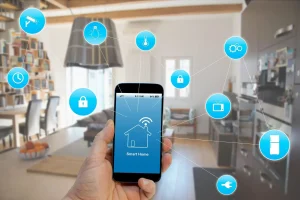A more secure smart home starts with a secure router

It’s hard to imagine a modern home without Wi-Fi and the Internet. Everyone has Wi-Fi, and as a tech guy, I’m always interested in the wireless routers people use. With the introduction of whole-home mesh Wi-Fi, the concept of dead spots is over. Despite all the advancements in wireless technology, one thing remains – cybercrime. They look for backdoors into our smart homes. Thankfully, there are some simple security steps we can take to protect our home network. Let’s take a look at how a safer smart home starts with a secure router.
Choose a custom wireless network name and password
I’m old enough to remember when wireless routers first hit the market. At the time, wireless networking was turned on by default. This means anyone can log into your Wi-Fi network without entering a password. It wasn’t long before wireless routers came out with a default SSID and password. SSID stands for Service Set Identifier. This is the network name of your Wi-Fi network. This information is usually placed on the bottom of the router.
A good suggestion is to take the time to create a custom SSID and password. This information should only be known to you and your family. Remember, anyone who comes near you will see your Wi-Fi network name on their device. I recommend against using your last name in the SSID (eg SmithFamilyWiFi). Keep it generic so people can’t pinpoint your SSID. Some people like to use creative SSID names to deter hackers. For example, I’ve seen network names like “Click4Virus” or “FBI surveillance.” Make sure you only give your password to trusted family members and don’t share it with others.
Create a separate guest network
At some point, someone will ask for your Wi-Fi name and password to connect to the Internet on their personal device. They could be your friends, out-of-town guests, or extended family members. Virtually all routers allow the creation of secondary guest networks. This has several advantages. First, a guest network provides access to the Internet but restricts access to the home network. This protects access to discoverable devices on your home network. This could be a printer or a network attached storage (NAS) device.
Second, it protects your private files and devices. If people can access your main Wi-Fi, they can access smart home devices like smart speakers and smart TVs. Guest networking prevents this. Finally, it provides guests with convenient Wi-Fi access. For example, I have a guest network in my Airbnb suite at home. I print out the names and passwords of my Wi-Fi networks and hang them on the wall. When guests check in, they can easily connect to the Wi-Fi network.
router application
Enable firewall protection
Every router provides firewall protection. Firewall is just like its name. It provides a barrier between your Wi-Fi network and the Internet. By enabling firewall protection, incoming and outgoing network traffic can be filtered according to a set of predefined rules. It’s your first line of defense against threats like malware, viruses, and ransomware. A firewall actively monitors incoming traffic and blocks suspicious activity before it reaches your network. Plus, it limits your smart home devices’ exposure to the outside internet. That means firewalls can protect smart speakers and smart security cameras from hackers and cybercriminals.
If there’s only one thing you can do to protect your smart home, it’s enable firewall protection. Personally, I don’t think I’ve ever disabled it. Hackers look for networks without firewall protection, so make sure to enable a firewall in your router settings.
router on table
Set Up Automatic Updates for Your Router
After firewalling, make sure to enable automatic updates. It’s the next best security measure for your smart home. Router manufacturers regularly release firmware updates as new security vulnerabilities are discovered. It is important to minimize the chances of hackers getting into your network. Automatic updates ensure you always have the latest firmware. Usually the automatic firmware update happens around 3am. This is to minimize disruption to internet access. With automatic updates enabled, you’ll wake up to a safer network with no effort required. It’s a win-win situation – except for the hackers.







